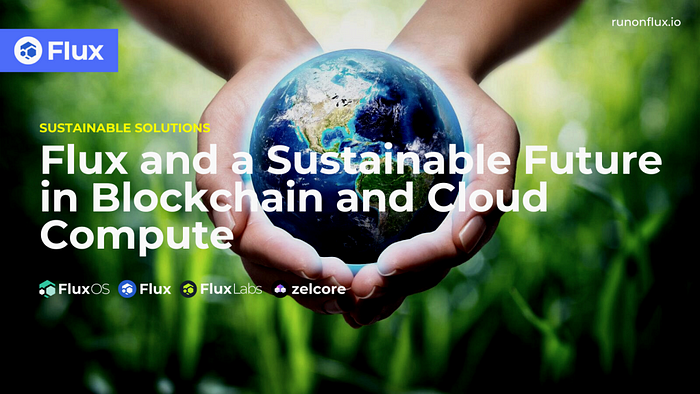Flux and a Sustainable Future in Blockchain and Cloud Computing.
All blockchain has a shared responsibility of building environmentally sustainable technology. Flux is actively developing sustainable solutions for proof of work and cloud computing. Flux believes that blockchain is not the cause of environmental problems but that it instead can provide solutions that will ultimately create more energy-efficient solutions than legacy technology can.

Flux is a project that aims to build the necessary infrastructure and development ecosystem to enable the next iteration of the Internet, Web3. It is a project focused on decentralization and using emerging technology to empower the people using the internet to take back stewardship of the internet from big tech. Flux is a project driven by a solid ethos to make the World a better place for generations.
To provide a truly decentralized network, a Web3 that is fairly distributed and owned by the people, Flux is utilizing blockchain technology and a ‘proof of work’ consensus method. Proof of work is essential to the Flux project as it secures the network while providing the best way to keep things decentralized and fair.
Proof of work has consistently met some critique for being harmful to the environment due to the energy needed to do the complex calculations required to secure blockchains, the activity known as mining. The US Biden administration recently published their report ‘Climate and Energy Implications of Crypto-Assets in the United States, where concerns are raised about the impact of crypto mining on the United States' ability to meet its goals of Carbon reductions.
Flux is already working on creating more sustainable solutions for proof of work blockchain and cloud computing. The Flux ethos of improving the world also extends to responsibly utilizing energy. Flux does this through active development and innovation, exploring how emerging technology and blockchain is part of the solution rather than being scapegoats for energy-intensive and inefficient industries.
More than words, Flux action on sustainable solutions on the blockchain.
Action speaks louder than words, so let’s look at how Flux is actively making Flux, proof of work, and cloud computing more sustainable.
Flux utilizes an ASIC-resistant mining algorithm to keep things fair and decentralized and keep the energy levels spent on mining in check. Bitcoin and Ethereum can be mined with ASICS, which creates a run on hash rates as ASICS mines very efficiently and is usually deployed at an industrial level. It takes 143 mWh of power to make one Bitcoin and about 3 kWh to make a Flux. So from its inception, Flux has taken measures to reduce the energy overhead of mining. This was a preliminary measure to make a larger impact on the sustainability of proof of work Flux has taken it upon itself to implement proof of useful work as a consensus method and as a path to a sustainable way of mining cryptocurrency. Flux is working with its partner, the Western Switzerland University of Applied Sciences in Geneva, to develop this innovative technology.
Proof of useful work still requires computational work to be done to secure a blockchain in a decentralized manner. With the current proof of work method, the computational power is being used to solve arbitrary problems with no other useful application than securing a blockchain. Proof of useful work ensures that the computational power is used for solving real-world problems while securing the blockchain simultaneously. This approach still requires power to do and still has a carbon footprint, but since that power is now utilized for doing two jobs at once, the net effect is less power used and less carbon emission. Here’s an example:
Computational work

Instead of two separate computational jobs being done, they are combined into one. The blockchain is secured by doing useful work that was required to be done either way. This results in a net reduction of power usage and carbon emission.
The development and deployment of the Flux proof of useful work algorithm will be a pivotal moment for all proof of work blockchains as Flux will share this technology with the blockchain industry.
Flux also has the most potent decentralized computational network of more than 14,000+ nodes, serving as a decentralized infrastructure for Web3. It’s an AWS-like ‘virtual’ data center where participation is open to all, and the servers are spread across the Globe.
Regarding power usage, data centers use an estimated 200–250 billion kWh per year globally. In conventional data centers, much of the capacity sits idle, ultimately wasting power. It is one of the significant challenges facing conventional data centers in their struggle to become more environmentally sustainable.
Flux aims to provide a more efficient organization of its ‘virtual’ data center with fewer resources being idle. The capacity of the Flux network is tied closely to supply and demand, with incentivization decreasing as the network outgrows demand. The Flux network can also scale faster and more agile than traditional data centers, as resources can join and leave the network anytime. By developing more flexible computing deployment and hosting models, Flux will build a more energy-efficient cloud solution than centralized providers can. Again Flux will actively leverage blockchain technology to build decentralized solutions that lower carbon footprints by being more efficient and less wasteful.
Making blockchain sustainable and energy efficient is an essential part of building Web3. Flux actively seeks ways to build a more sustainable and environmentally friendly blockchain. We’d love to join forces with others in this endeavor, as it should be a shared mission for all blockchains to protect the environment. If you have good ideas for making blockchain more sustainable, please seek and share them with us to develop a better future together.
We invite you to learn more about Flux.
The community fuels flux, so we invite you to participate. All are welcome, it doesn’t matter if you’re just interested in technology, an investor, a developer, or just like to make crypto memes all day. Flux needs all kinds of people to participate in the decentralized future.
Come check out the official Flux website hosted on the Flux decentralized network. Learn about the Flux ecosystem and see what’s on offer. Check out how to run Flux nodes or how to mine Flux.
If you want to witness what Flux has built so far, visit the Flux network dashboard and see how many nodes we’ve got online, check out the massive resources available to the network, see what decentralized apps are running and what the current rewards are for Flux node operators.
And also, please do stop by the Flux discord to meet the Flux team and community and discuss all things Flux; we’re always on the lookout for new community members or developers.
